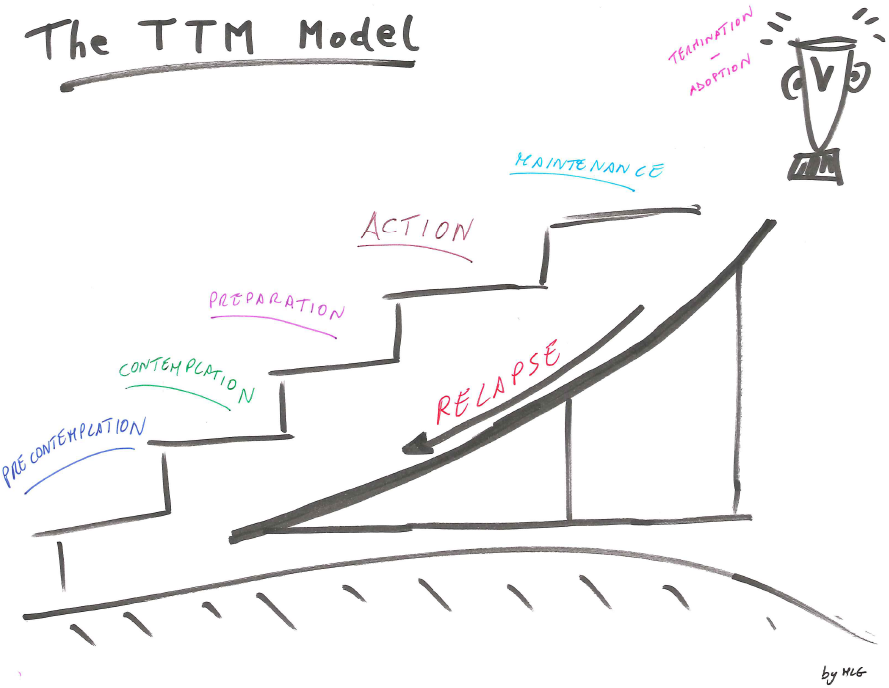Let’s face it, making changes in our lives is not easy. Sometimes we quit before even starting a new resolution, on other occasions we eventually manage to reach some results (i.e. “yes! I quit smoking”) that time reveals later to be only temporary (i.e. smoking again after few days/weeks of “abstinence”).
The process of change has been intensively studied and a scientific model developed called the “Transtheoretical Model of Behavior Change” (TTM) (Prochaska & DiClemente, 1983; Prochaska, DiClemente & Norcross, 1992).
Based on principles from over 35 years of scientific research, studies and practical applications, the TTM is a biopsychosocial and integrative model to describe the process of intentional behavior change.
TTM Process outlined
The concept behind the TTM is that people go through change as a process over time, and that this process can be divided into stages, represented in the graph below:
The Pre Contemplative Stage (or stage of denial)
People in this stage are not ready for any change. Or, better yet, they are not even aware of the need for a change.
For example, somebody who does not see him or herself as obese or overweight might not find a way to approach a change in lifestyle or undergo a diet plan.
The Contemplation Stage
This is the stage in which people realize they have a problem and they intend to change. The risk in this stage is to remain stuck in it for long time, this due to overthinking, chronic contemplation and procrastination.
The Preparation Stage (i.e. “Ready to go!”)
People in this stage are willing to take action in the immediate future. Some steps are required to be completed in this stage: looking for a gym, researching a healthier eating plan or a personal trainer, are just examples of the required plan for action, or preparation.
 The Action Stage (i.e. “Go!”)
The Action Stage (i.e. “Go!”)
In this stage we start to observe actions, modification in lifestyle and behaviors. This is one of the most difficult stages because people actually face the new “reality” and the chances of “relapse” (see further below) are frequent.
When people become committed and consistent, they start to see results, or outcomes. Those outcomes are a fundamental “kick” to keep morale up and maintain awareness and focus.
On the other side, people must be aware that they are creating a lifestyle change, not a quick fix. It takes up to 6 months to obtain a lifestyle change, and even more to completely embed it into someone’s own life (see Termination-Adoption stage).
The Maintenance Stage
People are being consistent for quite a long period of time (up to one year), they are seeing progress, they are motivated and ready to experience a successful implementation of the program of change. People in this stage are less tempted to relapse.
The Termination-Adoption Stage
Congratulations! You’ve made it! You have reached your goal of introducing a new positive habit in to your life. How long did it take? Average time to reach this stage is a minimum of 5 years. People who reach this stage have adopted a new habit and they feel it’s the most natural thing they can do in their life now.
Relapse: What Is It and How to Overcome It
There is always a chance for relapse. On the graph above it is represented as a slide, able to bring people back to any previous stage of the TTM.
Mental power and determination, together with commitment and focus, are the key factors of success.
Although science tells us that willpower is limited, we cannot give up before we start just because we may relapse.
I’ve personally met people who managed to quit smoking for 3 to 4 years. After that, confident to easily manage “one single cigarette a day”, they gradually increased their daily “allowance”. Guess what? Overnight they become smokers again.
So, be aware of your limits, and occasional cheating is completely allowed: it’s important to give your willpower some rest!
Based on the different phases illustrated above, there is no perfect recipe to manage personal behavior, since each individual is unique. There are, however, some universal tips to assist people in bypassing the obstacles typical of each stage.
Dealing with the Pre Contemplative Stage: Increase Awareness
Increasing awareness through education and information is the key. The more information about health risks and issues related to an unhealthy lifestyle, the more that person will understand that it’s better to start to do something now. Recognizing a problem is fundamental in the process of climbing the transformational ladder.
Dealing with Contemplative and Preparation Stages: Kick Your Motivation
People need emotions and stimuli to implement a change. A positive external environment (i.e. friends) or working on positive thoughts can help someone “jump” to the next level. In these stages, meditation, yoga, and respiration techniques are also helpful.
Dealing with Action Stage: Maintain Focus
 Results will come. Maintain focus and commitment. Monitor your activities, keep a food journal updated, use an app to track steps or log food. These are all tools that are available to everybody.
Results will come. Maintain focus and commitment. Monitor your activities, keep a food journal updated, use an app to track steps or log food. These are all tools that are available to everybody.
Remember to measure your “indicators” (i.e. weight, waist circumference or any other relevant factor in reaching your goal) but not being obsessed by them. If you are willing to lose weight and your scale indicates you have gained one or two pounds on the weekend, do not be discouraged!
Dealing with Maintenance and Termination/Adoption Stages: Plan Your New Goals
Once you have reached your goal, or you are near to it, celebrate! And then…set another challenging goal, finding new motivation patterns in order to keep the highest momentum.
Conclusions
The TTM, originally developed for smoking cessation, has demonstrated its validity for other studies as well including weight loss control, exercise adoption, and health behavior. The time needed for each stage is strictly based on each individual but the method is universally applicable. Sharing this kind of knowledge is important in raising awareness and is the first step in climbing the TTM staircase.
Manlio Lo Giudice is an Italian mechanical engineer, professional Health and Safety manager and passionate blogger. Manlio is working towards becoming a professional blogger, entrepreneur, biohacker and professional lifestyle and holistic coach. He is currently developing his own blog on www.theholisticexperiment.com.
REFERENCES and other resources:
http://www.ncbi.nlm.nih.gov/pubmed/25806569
http://www.ncbi.nlm.nih.gov/pubmed/10170434
http://www.ncbi.nlm.nih.gov/pubmed/7837962
http://www.ncbi.nlm.nih.gov/pubmed/14965439
https://www.apa.org/helpcenter/willpower-limited-resource.pdf

